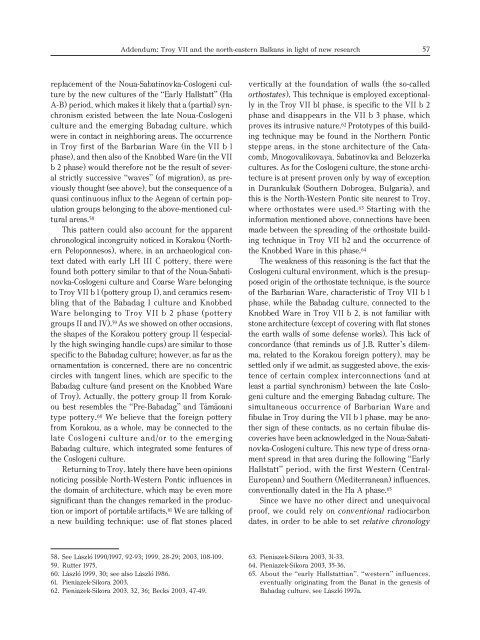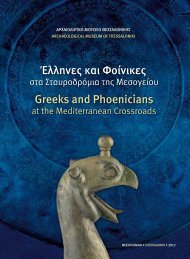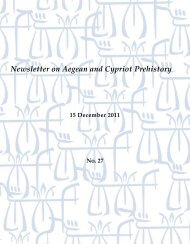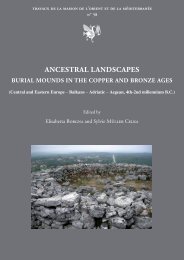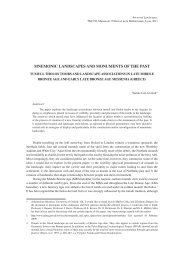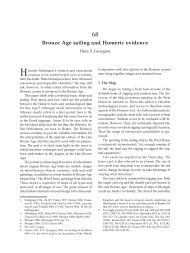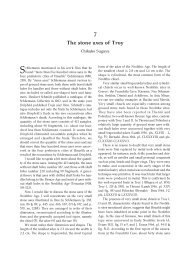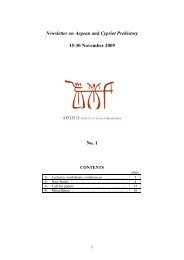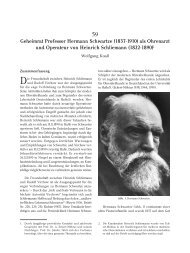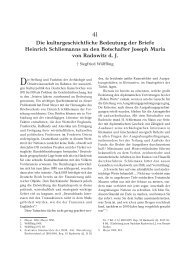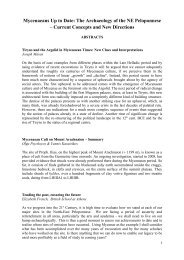- Seite 1 und 2:
ΑΡΧΑΙΟΛΟΓΙΑ ΚΑΙ ΕΡ
- Seite 3 und 4:
Περιεχόμενα - Contents -
- Seite 5 und 6:
Περιεχόμενα - Contents -
- Seite 7:
Περιεχόμενα - Contents -
- Seite 10 und 11:
XΠρόλογος - Foreword - Vorw
- Seite 13 und 14:
Κατάλογος συμμετεχ
- Seite 15 und 16:
Κατάλογος συμμετεχ
- Seite 17 und 18:
Χαιρετισμοί - Opening ce
- Seite 19 und 20:
Χαιρετισμοί - Οpening c
- Seite 21 und 22:
Χαιρετισμοί - Οpening c
- Seite 23 und 24:
Χαιρετισμοί - Οpening c
- Seite 25 und 26:
Χαιρετισμοί - Οpening c
- Seite 27 und 28:
Χαιρετισμοί - Οpening c
- Seite 29 und 30:
Χαιρετισμοί - Οpening c
- Seite 31 und 32:
Χαιρετισμοί - Οpening c
- Seite 33 und 34:
Χαιρετισμοί - Οpening c
- Seite 35 und 36:
Χαιρετισμοί - Οpening c
- Seite 37 und 38:
Πρόγραμμα Συνεδρίο
- Seite 39 und 40:
Πρόγραμμα Συνεδρίο
- Seite 41 und 42:
Επιτροπές - Committees - K
- Seite 43 und 44:
Δελτία τύπου - Press rel
- Seite 45 und 46:
Δελτία τύπου - Press rel
- Seite 47 und 48:
Ψήφισμα 21 ης Απριλί
- Seite 49 und 50:
Κατάλογος δημοσιευ
- Seite 51:
Συντομογραφίες - Abbr
- Seite 55 und 56:
1On the beginnings of field archaeo
- Seite 57: On the beginnings of field archaeol
- Seite 60 und 61: 8 Manfred Korfmannthe epithet “wi
- Seite 62 und 63: 10 Manfred Korfmannfinds and contex
- Seite 64 und 65: 12 Manfred Korfmannsplitting, uncon
- Seite 66 und 67: 14 Manfred Korfmannmight otherwise
- Seite 68 und 69: 16 Donald F. EastonFig. 1. Reconstr
- Seite 70 und 71: 18 Donald F. Eastonmann 1880 no. 14
- Seite 72 und 73: 20 Donald F. EastonFig. 5. Reconstr
- Seite 74 und 75: 22 Donald F. EastonFig. 9. Pottery
- Seite 76 und 77: 24 Donald F. EastonIn terms of rela
- Seite 78 und 79: 26 Donald F. EastonTo the architect
- Seite 80 und 81: 28 Donald F. EastonFig. 18. Reconst
- Seite 82 und 83: 30 Donald F. EastonFig. 20. Chronol
- Seite 84 und 85: 32 Donald F. Easton99-153.Evans, R.
- Seite 86 und 87: 34 Donald F. EastonWeninger, B., 19
- Seite 88 und 89: 36 Edmund Bloedowstatements in this
- Seite 90 und 91: 38 Edmund Bloedowarchaeological sen
- Seite 92 und 93: 40 Edmund Bloedowobjection”, we w
- Seite 94 und 95: 42 Edmund BloedowTo sum up, in view
- Seite 96 und 97: 44 Martin EmeleAlle publizierten Br
- Seite 98 und 99: 46 Martin Emele9. und 8. Jahrundert
- Seite 100 und 101: 48 Martin EmeleNiedergang der myken
- Seite 103 und 104: Troy and the lower Danube region at
- Seite 105 und 106: Addendum: Troy VII and the north-ea
- Seite 107: Addendum: Troy VII and the north-ea
- Seite 112 und 113: La′ szlό, A., 2006. ‘Über die
- Seite 114 und 115: 62 Angelika Dousougli und Konstanti
- Seite 116 und 117: 64 Angelika Dousougli und Konstanti
- Seite 118 und 119: 66 Chikako Sugayawere found in the
- Seite 120 und 121: 68 Chikako SugayaIt has been assume
- Seite 122 und 123: 8Schliemann’s Mycenae Albums 1Sin
- Seite 124 und 125: 72 Sinclair HoodFig. 1. Plan of Myc
- Seite 126 und 127: 74 Sinclair Hoodthere are altogethe
- Seite 128 und 129: 76 Sinclair Hooddon Nicolaou by nam
- Seite 130 und 131: 78 Sinclair HoodVasen (1886), some
- Seite 132 und 133: 80 David A. Traillacropolis there w
- Seite 134 und 135: 82 David A. Traillwhat soil the sla
- Seite 136 und 137: 84 David A. Traillonly fair to poin
- Seite 138 und 139: 86 Alexander Häuslerchtgräbern vo
- Seite 140 und 141: 88 Alexander Häuslerhört zu den K
- Seite 142 und 143: 90 Alexander Häuslerden neuentdeck
- Seite 144 und 145: 92 Alexander Häuslerund Wagen im n
- Seite 146 und 147: 94 János MakkayB1 period). 10 Six
- Seite 148 und 149: 96 János Makkay8. The sacrificial
- Seite 150 und 151: 98 János Makkay• Aphidna (Attica
- Seite 152 und 153: 100 János MakkayEvidence briefly s
- Seite 154 und 155: 102 János Makkay(Conquests in the
- Seite 156 und 157: 12Die Bernsteinschieber von MykeneS
- Seite 158 und 159:
106 Silvia SchulzSchieber ganz erha
- Seite 160 und 161:
108 Silvia SchulzEssingen, Kr. Aale
- Seite 162 und 163:
110 Silvia SchulzHuntiscarth (Orkne
- Seite 164 und 165:
112 Silvia SchulzIn Deutschland, sp
- Seite 166 und 167:
114 Silvia Schulzdem hat man auch d
- Seite 168 und 169:
116 Silvia SchulzAbb. 13. Umzeichnu
- Seite 170 und 171:
13Weapons in the Shaft Graves of My
- Seite 172 und 173:
120 Piotr Taracha(Karo 216a, 216b,
- Seite 174 und 175:
122 Piotr TarachaA swords (of four
- Seite 176 und 177:
14100 Jahre Ausgrabungen in Tiryns:
- Seite 178 und 179:
126 Klaus Kilianplan der Gräber vo
- Seite 180 und 181:
128 Klaus KilianLITERATURVERZEICHNI
- Seite 182 und 183:
15Γεωλογικές παρατη
- Seite 184 und 185:
132 Mιχάλης ∆ερµιτζά
- Seite 186 und 187:
134 Mιχάλης ∆ερµιτζά
- Seite 188 und 189:
136 Mιχάλης ∆ερµιτζά
- Seite 190 und 191:
16A physical and human geographic a
- Seite 192 und 193:
140 Fivos PapadimitriouI. Earthquak
- Seite 194 und 195:
17Η µεσοελλαδική κε
- Seite 196 und 197:
144 Kαλλιόπη ΣαρρήΤο
- Seite 198 und 199:
146 Kαλλιόπη Σαρρήνο
- Seite 200 und 201:
148 Kαλλιόπη ΣαρρήΠί
- Seite 202 und 203:
150 Kαλλιόπη ΣαρρήΠί
- Seite 205:
II.Eρρίκος Σλήµαν. O ά
- Seite 208 und 209:
156 Wilfried Bölkebesser als das h
- Seite 210 und 211:
158 Wilfried BölkeAbb. 2. Dorfkirc
- Seite 212 und 213:
160 Wilfried BölkeMehrmals hatte e
- Seite 214 und 215:
162 Wilfried Bölkebis Mittag. Sein
- Seite 216 und 217:
19Name und Wappen unserer Familie S
- Seite 218 und 219:
166 Hans SchliemannAbb. 1. Schliema
- Seite 220 und 221:
168 Hans SchliemannKnüppel, währe
- Seite 222 und 223:
170 Hans SchliemannSippen des Namen
- Seite 224 und 225:
172 Galina Andrusovova′-Vlcekova
- Seite 226 und 227:
174 Galina Andrusovova′-Vlcekova
- Seite 228 und 229:
176 Galina Andrusovova′-Vlcekova
- Seite 230 und 231:
178 Galina Andrusovova′-Vlcekova
- Seite 233:
Heinrich Schliemann als Gro kaufman
- Seite 236 und 237:
22Ἑρρῖκος Σλῆμαν (1
- Seite 238 und 239:
186 Γεώργιος Στυλ. Κο
- Seite 240 und 241:
188 Γεώργιος Στυλ. Κο
- Seite 242 und 243:
190 Γεώργιος Στυλ. Κο
- Seite 244 und 245:
192 Γεώργιος Στυλ. Κο
- Seite 246 und 247:
194 Γεώργιος Στυλ. Κο
- Seite 248 und 249:
196 Γεώργιος Στυλ. Κο
- Seite 250 und 251:
198 Γεώργιος Στυλ. Κο
- Seite 252 und 253:
200 Γεώργιος Στυλ. Κο
- Seite 254 und 255:
202 Γεώργιος Στυλ. Κο
- Seite 256 und 257:
204 Γεώργιος Στυλ. Κο
- Seite 258 und 259:
206 Γεώργιος Στυλ. Κο
- Seite 260 und 261:
208 Γεώργιος Στυλ. Κο
- Seite 262 und 263:
210 Γεώργιος Στυλ. Κο
- Seite 264 und 265:
212 Γεώργιος Στυλ. Κο
- Seite 266 und 267:
214 Γεώργιος Στυλ. Κο
- Seite 268 und 269:
216 Γεώργιος Στυλ. Κο
- Seite 270 und 271:
218 Γεώργιος Στυλ. Κο
- Seite 272 und 273:
220 Γεώργιος Στυλ. Κο
- Seite 274 und 275:
222 Γεώργιος Στυλ. Κο
- Seite 276 und 277:
224 Γεώργιος Στυλ. Κο
- Seite 278 und 279:
226 Γεώργιος Στυλ. Κο
- Seite 280 und 281:
228 Hans EinsleFälscher beschuldig
- Seite 282 und 283:
230 Hans Einslewurden gebaut und wi
- Seite 284 und 285:
232 Hans Einslespreche ich Dir heut
- Seite 286 und 287:
24Heinrich Schliemann, the linguist
- Seite 288 und 289:
236 Elizabeth Carvalhoinability to
- Seite 290 und 291:
25Schliemanns archäologische Leben
- Seite 292 und 293:
240 Wolfgang Richterdie deutsche Ü
- Seite 294 und 295:
242 Wolfgang Richterseines Landsman
- Seite 296 und 297:
26Schliemann als Zeitgenosse† Wol
- Seite 298 und 299:
246 Wolfgang Schindlergenossen der
- Seite 300 und 301:
27Schliemanns Beziehungen zu Berlin
- Seite 302 und 303:
250 Reinhard Wittewenden uns andere
- Seite 304 und 305:
252 Reinhard Wittejähriger Vorsitz
- Seite 306 und 307:
254 Reinhard WitteLITERATURVERZEICH
- Seite 308 und 309:
256 Horst Korsinski,,Dat Trojasehe
- Seite 311 und 312:
29Sergej Schliemanns Briefe an den
- Seite 313 und 314:
30Wiederaufgefundene Briefe Heinric
- Seite 315 und 316:
Wiederaufgefundene Briefe Heinrich
- Seite 317 und 318:
Heinrich Schliemann und die preußi
- Seite 319 und 320:
32Briefwechsel H. Schliemannsmit N.
- Seite 321 und 322:
Briefwechsel H. Schliemanns mit N.
- Seite 323 und 324:
Briefwechsel H. Schliemanns mit N.
- Seite 325 und 326:
Briefwechsel H. Schliemanns mit N.
- Seite 327 und 328:
Entwicklung von Forschungsmethoden
- Seite 329 und 330:
Entwicklung von Forschungsmethoden
- Seite 331 und 332:
34Bismarck und Schliemann† Johann
- Seite 333 und 334:
Bismarck und Schliemann 281mer in e
- Seite 335 und 336:
Bismarck und Schliemann 283Irmscher
- Seite 337 und 338:
35Arthur Milchhöfer, ein Verehrer
- Seite 339 und 340:
Arthur Milchhöfer, ein Verehrer un
- Seite 341 und 342:
Arthur Milchhöfer, ein Verehrer un
- Seite 343 und 344:
Arthur Milchhöfer, ein Verehrer un
- Seite 345 und 346:
Arthur Milchhöfer, ein Verehrer un
- Seite 347 und 348:
Arthur Milchhöfer, ein Verehrer un
- Seite 349 und 350:
Arthur Milchhöfer, ein Verehrer un
- Seite 351 und 352:
Arthur Milchhöfer, ein Verehrer un
- Seite 353 und 354:
Arthur Milchhöfer, ein Verehrer un
- Seite 355 und 356:
Arthur Milchhöfer, ein Verehrer un
- Seite 357 und 358:
Arthur Milchhöfer, ein Verehrer un
- Seite 359 und 360:
Arthur Milchhöfer, ein Verehrer un
- Seite 361 und 362:
Arthur Milchhöfer, ein Verehrer un
- Seite 363 und 364:
Arthur Milchhöfer, ein Verehrer un
- Seite 371 und 372:
37Die Briefe Heinrich Schliemanns a
- Seite 373 und 374:
Die Briefe Heinrich Schliemanns an
- Seite 375 und 376:
38Schliemann καd Gladstone, µί
- Seite 377 und 378:
Schliemann καd Gladstone, µία
- Seite 379 und 380:
Schliemann καd Gladstone, µία
- Seite 381 und 382:
Wilhelm Dörpfeld: Schliemann’s i
- Seite 383 und 384:
Wilhelm Dörpfeld: Schliemann’s i
- Seite 385 und 386:
40Quellen von und über Heinrich Sc
- Seite 387 und 388:
Quellen von und über Heinrich Schl
- Seite 389 und 390:
Quellen von und über Heinrich Schl
- Seite 391 und 392:
Quellen von und über Heinrich Schl
- Seite 393 und 394:
Quellen von und über Heinrich Schl
- Seite 395 und 396:
Quellen von und über Heinrich Schl
- Seite 397 und 398:
Quellen von und über Heinrich Schl
- Seite 399 und 400:
Quellen von und über Heinrich Schl
- Seite 401 und 402:
Die kulturgeschichtliche Bedeutung
- Seite 403 und 404:
Die kulturgeschichtliche Bedeutung
- Seite 405:
Die kulturgeschichtliche Bedeutung
- Seite 409 und 410:
42Homer, Mycenae and Troy: Problems
- Seite 411 und 412:
Homer, Mycenae and Troy: Problems a
- Seite 413 und 414:
Homer, Mycenae and Troy: Problems a
- Seite 415 und 416:
Homer, Mycenae and Troy: Problems a
- Seite 417 und 418:
43Schliemann’s initial views on H
- Seite 419 und 420:
Schliemann’s initial views on Hom
- Seite 421 und 422:
Schliemann’s initial views on Hom
- Seite 423 und 424:
44Schliemanns ,,Homerismus“ und d
- Seite 425 und 426:
Schliemanns ,,Homerismus“ und die
- Seite 427 und 428:
Schliemanns ,,Homerismus“ und die
- Seite 429 und 430:
Schliemanns ,,Homerismus“ und die
- Seite 431 und 432:
45The Dream of Troy. The Literal ve
- Seite 433 und 434:
The Dream of Troy 381Priam, and the
- Seite 435 und 436:
The Dream of Troy 383of the Hisarli
- Seite 437 und 438:
Schliemann und die Schriftlichkeit
- Seite 439 und 440:
Schliemann und die Schriftlichkeit
- Seite 441:
V.O Σλήµαν ως αρχαιο
- Seite 444 und 445:
392 Oliver T.P.K. Dickinsonvery dif
- Seite 446 und 447:
394 Oliver T.P.K. Dickinsonbut it s
- Seite 448 und 449:
396 Oliver T.P.K. Dickinsoninserted
- Seite 450 und 451:
398 Oliver T.P.K. Dickinsonmen hard
- Seite 452 und 453:
400 Oliver T.P.K. DickinsonREFERENC
- Seite 454 und 455:
402 Eéαγγελία Πρωτον
- Seite 456 und 457:
49Beobachtungen zur Chronologie und
- Seite 458 und 459:
406 Stefan Hillerwirkenden zyklopis
- Seite 460 und 461:
408 Stefan Hillergibt er als grobe
- Seite 462 und 463:
410 Stefan HillerLITERATURVERZEICHN
- Seite 465 und 466:
50Trojanische Altertümer in der Un
- Seite 467 und 468:
Trojanische Altertümer in der Univ
- Seite 469 und 470:
Der Schatten des geraubten Goldes 4
- Seite 471 und 472:
Der Schatten des geraubten Goldes 4
- Seite 473 und 474:
52‘The help of my dear wife’: S
- Seite 475 und 476:
‘The help of my dear wife’: Sop
- Seite 477 und 478:
53Zu Geschichte, Schicksal und heut
- Seite 479 und 480:
Zu Geschichte, Schicksal und heutig
- Seite 481 und 482:
Zu Geschichte, Schicksal und heutig
- Seite 483 und 484:
54Rekonstruktion und Nachbildung vo
- Seite 485 und 486:
Rekonstruktion und Nachbildung von
- Seite 487 und 488:
Rekonstruktion und Nachbildung von
- Seite 489 und 490:
Rekonstruktion und Nachbildung von
- Seite 491:
VII.Tο Iλίου MέλαθρονIl
- Seite 494 und 495:
442 Erhard HirschAbb. 1. Robert Ada
- Seite 496 und 497:
444 Erhard HirschResidenz. 9 Das Be
- Seite 498 und 499:
446 Erhard HirschAbb. 7. Potsdam-Sa
- Seite 500 und 501:
448 Erhard HirschHirsch, E., 1985.
- Seite 502 und 503:
450 Aναστάσιος Πορτε
- Seite 504 und 505:
452 Aναστάσιος Πορτε
- Seite 506 und 507:
454 Aναστάσιος Πορτε
- Seite 508 und 509:
456 Aναστάσιος Πορτε
- Seite 510 und 511:
458 Aναστάσιος Πορτε
- Seite 512 und 513:
460 Aναστάσιος Πορτε
- Seite 514 und 515:
462 Aναστάσιος Πορτε
- Seite 516 und 517:
464 Aναστάσιος Πορτε
- Seite 518 und 519:
466 Emanuel TurczynskiGriechenland
- Seite 521:
VIII.H εγχείρηση και ο
- Seite 524 und 525:
472 Christian Andreehäufig bei Men
- Seite 526 und 527:
474 Christian Andreeerweiterte Anze
- Seite 528 und 529:
59Geheimrat Professor Hermann Schwa
- Seite 530 und 531:
478 Wolfgang Koallerforderten eine
- Seite 532 und 533:
60The operation and death of Henry
- Seite 534 und 535:
482 Francis H. McGovernAthens for C
- Seite 536 und 537:
61Il funerale di Heinrich Schlieman
- Seite 538 und 539:
486 Nicola A. Livadarasnazione grec
- Seite 540 und 541:
488 Xαράλαµπος Σκουλ
- Seite 542 und 543:
490 Xαράλαµπος Σκουλ
- Seite 544 und 545:
63Ἡ ἐκτέλεσις τῆς
- Seite 546 und 547:
494 Γεώργιος Στυλ. Κο
- Seite 548 und 549:
496 Γεώργιος Στυλ. Κο
- Seite 550 und 551:
498 Γεώργιος Στυλ. Κο
- Seite 553:
IX.Eπιµέρους θέµαταMi
- Seite 556 und 557:
504 Hans-Dieter ZimmermannAbb. 1. D
- Seite 558 und 559:
506 Hans-Dieter Zimmermanngemietet.
- Seite 560 und 561:
508 Hans-Dieter Zimmermannbeide zu
- Seite 562 und 563:
510 Rainer HilseAbb. 1. HSG in Troj
- Seite 564 und 565:
512 Rainer Hilsedurch die Mitwirkun
- Seite 566 und 567:
514 Rainer HilseAbb. 3. Versammlung
- Seite 568 und 569:
66Kein Museum für Schliemann.Eine
- Seite 570 und 571:
518 Ellen Katja Jaeckeldings beschr
- Seite 572 und 573:
520 Iωάννα ΣταυράκηΟ
- Seite 574 und 575:
522 Iωάννα ΣταυράκηΕ
- Seite 576 und 577:
524 Hara S. Georgiouterminates dire
- Seite 578 und 579:
526 Hara S. Georgiouchorage or moor
- Seite 580 und 581:
528 Hara S. Georgiouthan difference


